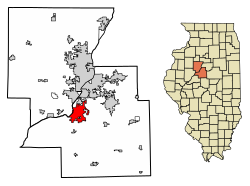
Pekin, Illinois

Pekin | |
|---|---|
 | |
| Motto: "Community' Opportunity' Home" | |
 Location of Pekin in Tazewell and Peoria counties, Illinois | |
 Location of Illinois in the United States | |
| Coordinates: 40°34′04″N 89°37′30″W / 40.56778°N 89.62500°W[2] | |
| Country | United States |
| State | Illinois |
| Counties | Tazewell; Peoria[1] (small portion) |
| Townships | Pekin, Hollis |
| Named for | Beijing, China |
| Government | |
| • Mayor | Mary Burress |
| Area | |
| • City | 16.57 sq mi (42.91 km2) |
| • Land | 15.72 sq mi (40.71 km2) |
| • Water | 0.85 sq mi (2.20 km2) |
| Elevation | 538 ft (164 m) |
| Population (2020) | |
| • City | 31,731 |
| • Density | 2,019/sq mi (5,229.19/km2) |
| • Metro | 402,391 |
| Time zone | UTC−6 (CST) |
| • Summer (DST) | UTC−5 (CDT) |
| ZIP Code(s) | 61554 61555 (P.O. Boxes only) |
| Area code | 309 |
| FIPS code | 17-58447 |
| GNIS feature ID | 2396172[2] |
| Website | www |
Pekin (/ˈpiːkɪn/ PEE-kin) is a city in and the county seat of Tazewell County in the U.S. state of Illinois. Located on the Illinois River, Pekin is the largest city of Tazewell County and the second most populous municipality of the Peoria metropolitan area, after Peoria itself.[4] As of the 2020 census, its population is 31,731.[5] A small portion of the city limits extend into Peoria County. It is a suburb of Peoria and is part of the Peoria Metropolitan Statistical Area.

Pekin's Mineral Springs Park is near Pekin Hospital and the Miller Senior Center. The city is the location of a high-rise residential facility of the United Auto Workers; the location of the Pekin Federal Correctional Institution; and the headquarters of a regional insurance company, Pekin Insurance.

History
Origins of Pekin

Farmer Jonathan Tharp, who came from Ohio, was the first non-native American resident of what would become Pekin, building a log cabin in 1824 on a ridge above the Illinois River at a site near the present foot of Broadway Drive. Franklin School was later erected near this site. Other settlers soon joined him, including his father Jacob Tharp who arrived from Ohio in 1825. They lived near Chief Shabbona's large Indian village of about 100 wigwams, populated primarily by Potawatomi, which was situated along Gravel Ridge, on the eastern shore of what is today Pekin Lake in northwest Pekin.[6]

The county surveyor, William Hodge, measured and laid out a "town site" in 1827. In 1829, the plat was taken to Springfield and auctioned; the town site was awarded to Major Isaac Perkins, Gideon Hawley, William Haines and Major Nathan Cromwell.[7] Major Cromwell's wife, Mrs. Ann Eliza Cromwell, selected the name of Pekin.[8] It has been stated that Mrs. Cromwell named the town "Pekin" because she thought Peking was on the exact opposite side of the world from the town she founded.[9][10] In the 1800s, China and the United States were thought to be antipodes, or locations that were exactly opposite of each other on the globe. As such, towns were sometimes named after their supposedly antipodal locations. Another example is Canton, Ohio.[11] "Peking" was often romanized as "Pekin", as in other towns founded during the 1800s (such as Pekin, Ohio).

Nathan Cromwell named many of the city streets after the wives and daughters of early Pekin settlers. It was long held, as first expressed by W.H. Bates in the 1870 Pekin City Directory, that Cromwell was assisted by his wife Ann Eliza in the naming of the streets.[12]

19th century
Pekin's first post office opened on February 20, 1832.[13]

In July 1834, Pekin suffered a cholera outbreak.[14][15] Several early settlers died in the outbreak and were buried in the old Tharp cemetery.[14] There was also a scarlet fever outbreak in winter 1843–1844.[16]

Pre-Civil War
Pekin was the residence of Nance Costley, known to history as the first enslaved person to be freed with the help of Abraham Lincoln. She was auctioned off to Nathan Cromwell in 1827 and brought to Pekin.[17] Her original case was part of a Probate Court hearing regarding the estate when he died in 1836. David Bailey, a local merchant of abolitionist leanings, sought the help of an attorney friend after he (and Nance) lost the case.[18] Abraham Lincoln argued the case in 1841 at the Illinois Supreme Court, citing the Illinois Constitution and Northwest Ordinance.[19] Justice Breese determined that Nance was a free person and reversed the Circuit Court ruling, stating that "it is a presumption of law, in the State of Illinois, that every person is free, without regard to color," and "the sale of a free person is illegal".[20] After her freedom was legally secured, she remained in Pekin with her husband and children. In William H. Bates' 1870 Pekin City Directory, Nance was included in an entry of notable citizens:

"With the arrival of Major Cromwell ... came a slave. That slave still lives in Pekin and is now known, as she has been known for nearly half a century ... (as) 'Black Nancy.' She came here a chattel. ... But she has outlived the age of barbarism, and now, in her still vigorous old age, she sees her race disenthralled; the chains that bound them forever broken, their equality before the law everywhere recognized and her children enjoying the elective franchise."
Lincoln attended the Whig Convention that was held in Pekin on May 1, 1843. He was among several local Whig politicians who wanted to serve in the U.S. Congress. To keep from splitting the Whig vote, the competitors agreed to support each other for one term each in Congress.[21] Lincoln ran and was elected to the 30th United States Congress in 1846, and retired at the end of the term. This single term in Congress was Lincoln's only experience in Washington before he was elected president.[22]

Although Illinois was a "free" state, pro-slavery sentiment was predominant throughout southern and central Illinois, which had been largely settled by Southerners, some of whom were slaveholders before the state was admitted to the union. Cities with pro-slavery sentiment included Peoria and Pekin.[23] According to the 1949 Pekin "Centenary," p. 15,

"Pekin was a pro-slave city for years. Some of the original settlers had been slave-owners themselves, and the overwhelming sentiment in Pekin was Democratic. Stephen A. Douglas, not Abraham Lincoln, was the local hero, although Lincoln was well-liked, and had some German following."
Nonetheless, there was abolitionist sentiment in Pekin. Among Pekin's abolitionist leaders was Dr. Daniel Cheever, who performed Underground Railroad activities in his office at the corner of Capitol and Court streets[24] (in addition to his property in Delavan which was an Underground Railroad depot)[25] and the brothers Samuel and Hugh Woodrow. (Catherine Street in Pekin is named for Samuel's wife, and Amanda Street is named for Hugh's wife).[26] The sentiment was bolstered by the German immigrants that arrived in the area after the Revolutions of 1848; while there were small groups that supported slavery, finding them would prove difficult as the German community disapproved of the idea.[27]

Civil War
During the Civil War, the inhabitants of Pekin were divided between the pro-slavery element, who favored the Confederacy, and the abolitionist and pro-Union element. Early in the war, the secessionist "Knights of the Golden Circle" openly supported secession and slavery in Pekin. The 1949 Pekin Centenary, p. 15, says the Knights were "aggressive and unprincipled," and "those who believed in the Union spoke often in whispers in Pekin streets and were wary and often afraid." As a response to the Knights' influence, Dr. Cheever and 10 other men gathered at 331 Court Street in Pekin on June 25, 1862, to establish the first council of the Union League of America.[24] The goal of the League was to promote patriotism and loyalty to the Union in the Civil War and the abolition of slavery. Its members hoped to counter Northern disillusionment with President Lincoln's military policies after early Union defeats in the American Civil War. Although closely allied with the Republican Party, the League sought to enroll all Union supporters, regardless of party. The anti-slavery Germans of Pekin took an active role in the Union League in their city.[citation needed]

German immigration to Pekin
After the Revolutions of 1848, many people from the German Confederation immigrated to the United States. During the decade of the 1850s, a 118.6% increase in the German-born population was observed.[28] In the 1850 Tazewell County census, nearly 14% of Pekin's population was listed as originating from "Germany" (272 individuals of the 1,891 listed).[29] In the 1860 Tazewell County census, the portion of Pekin that originated from Germany increased to 22% (774 individuals of the 3,467 listed).[30] The 1860 census also changed the designation from "Germany" to the various states of the German Confederation- revealing that 31% of the German immigrants came from Hanover, with Darmstadt trailing behind at 22% of the population.

Several German citizens of Pekin held status in the town. Frederick P. Siebens, who came to Pekin in 1868, was stockholder and director of T. & H. Smith Company (a blacksmith, woodworking, and wagon building plant).[31][32] He was also listed as a foreman blacksmith in the 1887 Pekin City Directory.[33] John Herget moved to the United States from Hesse-Darmstadt, then returned to Germany and brought his family back with him to Pekin in 1869. He became a stockholder in Farmers National Bank and was Mayor of Pekin in 1873 and 1874.[34] John's younger brother, George Herget, was the President of the Globe Distilling Company, the Pekin Electric Light Company, and the Pekin Steam Coopering Company. He settled in Pekin in 1853 after traveling from Gettysburg, Pennsylvania.[35] The historic Carl Herget mansion was listed on the National Register of Historic Places.[32] Habbe Vander Velde, one of the original founders of T. & H. Smith Company, served several terms on Pekin's city council, was Chairman of the Finance Committee, and a member of the Committee on Bridges and Licenses. He moved to Pekin in 1851.[36] Aeilt Van Boening was the city's representative for the Anheuser-Busch Brewing Company of St. Louis. He moved to Pekin in 1867 to be with his brothers, who had settled there in 1866.[37] Van Boening was also listed as a proprietor for City Truck Line in the 1887 Pekin City Directory.[38]

George Herget and Habbe Vander Velde were among those on the "Roll of Honor" in the 1908 Pekin City Directory. Those who were listed were in the 1861 Pekin City Directory and lived continuously or retained citizenship in Pekin since. The list describes those listed to "represent all the varied trades and professions which were essential to the building up of our beautiful city".[39]

In 1852, a short-lived German language newspaper Per Wachteram Illinois was published. Circa 1875, John Hoffman started a German weekly called the Pekin Freie Press.[40] This publication was sold to Albert Weiss, then to Jacob Schmidt in 1914. During World War I, this newspaper was changed to English language and renamed it Free Press; it was published until 1934.[40]

The northern part of town was known as "Bean Town".[41] Before World War I, German was a second language in Pekin, some stores had signs indicating "German Spoken Here", and some churches offered German services.[41] Sacred Heart Roman Catholic Church conducted some services in German for the older members in this section of town.[41]

Railroad
The St. Louis, Peoria and Northern Railway (St. L. P. & N.) built a line into Pekin in 1898, constructing the Pekin Depot.[40]


20th century
The Pekin Federal Building was built in 1906 to house government offices, including the post office on the first floor.[13] The post office moved in 1966.[13]

Ku Klux Klan
In an early 20th-century revival, the Ku Klux Klan recruited new members as a fraternal organization, opposing new immigrants from southern and eastern Europe, and becoming influential in rapidly industrializing urban areas in the Midwest and West, as well as in the South. It had numerous members in Pekin and other Illinois cities.[42] In August 1924, the Pekin Klan hosted one of the largest "monster rallies" ever held in Illinois, with an estimated attendance of 25,000 to 45,000.[41] It was during this period that leading Klansmen took over ownership of the city newspaper, the Pekin Daily Times; they used it as an organ of Klan viewpoints.[41][43] The Klan owned the paper from September 1923 to June 1925; they sold off the paper within a few years, coinciding with their decline in membership.[41]

1936 General Strike
In February 1936, Pekin held a city-wide strike, only the fourth strike of its kind in United States history.[44]

Civil Rights era
The city had an identity and reputation as a sundown town;[45] it was known to be hostile to black residents and few settled there.[46] On the other hand, some Pekin church pastors participated in the civil rights marches of the 1960s, and U.S. Senator Everett Dirksen from Pekin was integral to achieving passage of the Civil Rights Act of 1964.[47][48] The Effingham Daily News published an article on Peoria attorney Joe Billy McDade on December 16, 1967, that addressed the sundown town policy, in which McDade alleged that Pekin posted a sign its border that read, "Nigger, don't let the sun set on you in Pekin."[49] The article further states, "There must be a thousand Negroes in Peoria who could have known that is NOT true."[49]

21st century
In 1995, Pekin became the first city in Illinois to develop an overlay zoning ordinance to protect groundwater.[50] In 2011, Laurie Barra became the first female mayor of Pekin.[51]

Geography
According to the 2010 census, the city has a total area of 15.14 square miles (39.2 km2), of which 14.56 square miles (37.7 km2) (or 96.17%) is land and 0.58 square miles (1.5 km2) (or 3.83%) is water.[52]

Pekin lies on the Illinois River, and its John T. McNaughton Bridge connects the city to a small area of land the city has annexed in Peoria County. Nearby towns include North Pekin, Marquette Heights, Creve Coeur, Groveland, Tremont, Morton, Washington, Lincoln, East Peoria, Peoria, Bartonville, Mapleton, Manito, Delavan, Dillon, Green Valley, Hopedale, and South Pekin.

Climate
Pekin, much like the rest of central Illinois, experiences a hot-summer continental climate.[53] Summers are warm to hot and humid with occasional heat waves. Winters are cold (sometimes severely) and snowy, though there are plenty of clear days in the winter. There is no "dry" season- precipitation is evenly distributed throughout the year, though late spring may be wetter than the rest of the year. July is the warmest month, while January is the coolest.

| Climate data for Pekin, Illinois, 1991–2020 normals | |||||||||||||
|---|---|---|---|---|---|---|---|---|---|---|---|---|---|
| Month | Jan | Feb | Mar | Apr | May | Jun | Jul | Aug | Sep | Oct | Nov | Dec | Year |
| Mean daily maximum °F (°C) | 33 (1) |
38 (3) |
51 (11) |
63 (17) |
74 (23) |
83 (28) |
86 (30) |
84 (29) |
78 (26) |
65 (18) |
50 (10) |
38 (3) |
62 (17) |
| Mean daily minimum °F (°C) | 17 (−8) |
21 (−6) |
31 (−1) |
42 (6) |
52 (11) |
62 (17) |
66 (19) |
64 (18) |
56 (13) |
44 (7) |
33 (1) |
23 (−5) |
43 (6) |
| Average precipitation inches (mm) | 2.1 (53) |
1.9 (48) |
2.7 (69) |
3.9 (99) |
4.7 (120) |
3.7 (94) |
3.5 (89) |
3.3 (84) |
3.5 (89) |
3.2 (81) |
2.7 (69) |
2.2 (56) |
37.4 (951) |
| Average relative humidity (%) | 81 | 81 | 74 | 74 | 77 | 67.3 | 84 | 81 | 74 | 69 | 72 | 78.0 | 76.0 |
| Source: National Oceanic and Atmospheric Administration | |||||||||||||
Demographics
| Census | Pop. | Note | %± |
|---|---|---|---|
| 1850 | 1,678 | — | |
| 1860 | 3,467 | 106.6% | |
| 1870 | 5,696 | 64.3% | |
| 1880 | 5,993 | 5.2% | |
| 1890 | 6,347 | 5.9% | |
| 1900 | 8,420 | 32.7% | |
| 1910 | 9,897 | 17.5% | |
| 1920 | 12,086 | 22.1% | |
| 1930 | 16,129 | 33.5% | |
| 1940 | 19,407 | 20.3% | |
| 1950 | 21,858 | 12.6% | |
| 1960 | 28,146 | 28.8% | |
| 1970 | 31,375 | 11.5% | |
| 1980 | 33,967 | 8.3% | |
| 1990 | 32,254 | −5.0% | |
| 2000 | 33,857 | 5.0% | |
| 2010 | 34,094 | 0.7% | |
| 2020 | 31,731 | −6.9% | |
| U.S. Decennial Census[57] | |||
As of the census of 2020,[5] there were 31,731 people, 13,706 households, and 8,721 families residing in the city. The population density was 2,019.0 inhabitants per square mile (779.5/km2). There were 14,849 housing units. The racial makeup of the city was 92.9% White, 3% African American, 0.2% Native American or Alaska Native, 0.5% Asian, 0.1% Native Hawaiian or Pacific Islander, 0.6% from other races, and 3% from two or more races. Hispanic or Latino people of any race were 2.6% of the population.

There were 13,706 households, out of which 22.6% had children under the age of 18 living with them, 37.5% were married couples living together, 31.5% had a female householder with no husband present, and 45.3% were non-families. 37.9% of all households were made up of individuals living alone, and 14.5% had someone living alone who was 65 years of age or older. The average household size was 2.24 and the average family size was 2.99.

In the city the population was spread out, with 21% under the age of 18 and 18.1% who were 65 years of age or older. The median age was 41.5 years. For every 100 females, there were 96.5 males. For every 100 females age 18 and over, there were 92.3 males.

The median income for a household in the city was $50,838, and the median income for a family was $68,784. Males had a median income of $43,485 versus $30,881 for females. The per capita income for the city was $28,704. About 11.5% of families and 15% of the population were living below the poverty line, including 19.1% of those under age 18 and 6.4% of those age 65 or over.[58]

Ancestry
According to the 2021 American Community Survey, the biggest ancestry groups were:

- German (7,733)
- Irish (3,516)
- English (3,186)
- European (2,297)
- American (1,880)
- Italian (1,875)
- French, except Basque (1,431)
"Other groups" contained 4,105 individuals, and "Unclassified or not reported" contained 10,738 individuals.[59]

Race/ethnicity
| Race / Ethnicity | Pop 2010[60] | Pop 2020[61] | % 2010 | % 2020 |
|---|---|---|---|---|
| White alone (NH) | 31,817 | 28,640 | 93.32% | 90.26% |
| Black or African American alone (NH) | 700 | 721 | 2.05% | 2.27% |
| Native American or Alaska Native alone (NH) | 130 | 119 | 0.38% | 0.38% |
| Asian alone (NH) | 213 | 222 | 0.62% | 0.70% |
| Pacific Islander alone (NH) | 7 | 11 | 0.02% | 0.03% |
| Some Other Race alone (NH) | 17 | 60 | 0.05% | 0.19% |
| Mixed Race/Multi-Racial (NH) | 392 | 1,203 | 1.15% | 3.79% |
| Hispanic or Latino (any race) | 818 | 755 | 2.40% | 2.38% |
| Total | 34,094 | 31,731 | 100.00% | 100.00% |
Economy
Coal mining
All of the coal that exists in the area formed about 300 million years ago; dead plant matter was buried, compressed, and subjected to heat and pressure during this time to create rocks full of coal. Since coal was cheaper than wood fuel and produced more energy, it became very popular and profitable to mine. In Pekin, there were at least four coal mines that existed: the Pekin Coal Mine, Regal Coal Mine, Tazewell Coal Mine, and Ubben Coal Mine.[62][63][64]

The Ubben Coal Mine began in 1900 and was run by the Ubben Coal Company until 1903, when Tazewell Coal Company took over production until the mine permanently closed in 1925. Over the course of 25 years, the mine produced 2,089,332 tons of coal. This mine was located south of Pekin Community High School's eastern campus at S6 T24 R4W.[65] Ubben also managed a second mine from 1911 to 1938 that was originally started by Louis Grant in 1891; they produced 928,146 tons of coal during their ownership, with a total of 1,217,196 tons overall. This mine was located near Meyer's Lake (formerly Lake Arlan) at S1 T24N R5W.[66]

The Pekin Coal Mining Company (also known as Schaefer's Mining Company) owned a mine (originally managed by David Grant) from 1939 to 1952, and produced 898,610 tons of coal during its ownership. This was a large mine, located under Broadmoor Junior High School, Willow Elementary School, and Schramm School at S36 T25N R5W.[67] When Fred Schaefer died, the mine was inspected and discovered to be unsafe. By 1951, the coal mining business had ended for Pekin.

The Regal Coal Mine was managed by the Regal Coal Company from 1920 to 1924, until it went out of business in 1925. It produced 102,287 tons of coal during this time. It crossed Broadway Street in the eastern part of town, with the southern half of the mine existing underneath the Parkway Golf Course and Coal Miner's Park at S6 T24N R4W.[68]

The Federal Bureau of Prisons operates the Federal Correctional Institution, Pekin.[69][70]

Arts and culture
Marigold Festival
The Marigold Festival is an annual event founded in 1973 to honor Everett Dirksen, a senator from Pekin.[71] While in the United States Congress, Dirksen tried to have the marigold named as the national floral emblem.[72][73] In support of Dirksen, the community began growing marigolds. While unsuccessful in the national flower contest, Dirksen's hometown of Pekin became known as the "Marigold Capital of the World".[74][75] The Marigold Festival occurs on the first weekend after Labor Day in September. Activities include the Marigold Parade, the crowning of Miss Marigold, live music, and an arts and crafts fair.[74]

Pekin Public Library
In the beginning, Pekin's library was organized by the Ladies Library Association. The purpose of this library was "not only to collect and establish a library of select and useful works, but also to promote a literary taste by encouraging lectures, holding discussions, etc."[76] Both the membership and collection outgrew their space, and it relocated twice; to the city firehouse in 1889 and the Steinmetz Building in 1899. Due to the increase in membership, the Association's board decided to inquire about the library becoming a free city library. In 1896, the city council agreed to make the library free and appointed a nine-member board of trustees.[77]

In 1900, board member Mary Gaither wrote to Andrew Carnegie, a philanthropist who was funding libraries for communities all over the country. With donated land from George Herget and $15,000 from Carnegie, a new library was finally built in 1902.[76][78] However, continued growth of the collection and increased usage resulted in the need to expand the library, and the Carnegie library was demolished in 1974.[79] A larger building was constructed in September 1974 and was the original home of the Dirksen Congressional Center (which later separated from the library and built its own facility in 2002).[80]

In 1973, President Richard Nixon traveled to Pekin at the request of Senator Dirksen's widow to dedicate the cornerstone of the new library.[81][82]

In 1995, the Illinois State Library nominated Pekin Public Library for the American Library Association's Bessie Boehm Moore Award for their networking opportunities, intergenerational programs that engaged all groups of the community, and services for the elderly.[citation needed]

Parks and recreation
The Pekin Park District is the second largest in the region (Peoria is the first) with 2,277 acres (921 ha) in 13 parks.[75][83] It is the fifth largest parks district in the state.[83] It is perhaps best known for Mineral Springs Park and its iconic restored pavilion.[75] The 220 acres (89 ha) park has a lagoon for fishing and paddle boats, sports fields, skating rink, skateboard park, Dragonland Water Park, miniature golf, and a dog park.[75]

McNaughton Park has hiking trails, a disc golf course, and horse trails.[75] Riverfront Park has a viewing platform along the Illinois River.[75]

Pekin has two golf courses, Parkview and Lick Creek, as well as a country club.[75][84][85]

There is a 4.3 mi (6.9 km) bike trail.

Government
Pekin is the county seat of Tazewell County, Illinois. Originally under an aldermanic form of government, the city switched to the commission form in 1911 (see Pekin Sesquicentennial 1824–1974, A History, p. 162), but since 1995 has had a city manager form of government. A mayor and six council members are elected to staggered 4-year terms in April of odd-numbered years. Candidates may start circulating nomination papers (available from the County Clerk's office) in September, but must file them in mid-December.

The historic Tazewell County Courthouse houses the 10th Circuit Court.

The Pekin Park District was established in 1902 and still operates, controlled by a 7-member Board of Commissioners elected by the public at the same elections the city council members are.[86]

While Illinois as a whole is represented in the Senate by Richard Durbin (D) and Tammy Duckworth (D), the state is split into 17 Congressional Districts for the House of Representatives. Pekin is split between Congressional Districts 16 and 17- the majority of Pekin is in District 16 and represented by Darrin LaHood (R).[87] Extreme southwestern Pekin is in District 17 and represented by Eric Sorensen (D).[88]

Regarding the Illinois Senate and Illinois House of Representatives, Pekin is split along County Road 1700 E into two districts for both. For the western division, Illinois Senate District 47 is represented by Neil Anderson (R) and Illinois House District 93 is represented by Travis Weaver (R).[89][90] For the eastern division, Illinois Senate District 44 is represented by Sally J. Turner (R) and Illinois House District 87 is represented by William E. Hauter (R).[91][92]

| Mayors of Pekin, Illinois | |||||||||||||||||||||||||||||||||||||||||||||||||||||||||||||||||||||||||||||||||||||||||||||||||||||||||||||||||||||||||||||||||||||||||||||||||||||||||||||||||||||||||
|---|---|---|---|---|---|---|---|---|---|---|---|---|---|---|---|---|---|---|---|---|---|---|---|---|---|---|---|---|---|---|---|---|---|---|---|---|---|---|---|---|---|---|---|---|---|---|---|---|---|---|---|---|---|---|---|---|---|---|---|---|---|---|---|---|---|---|---|---|---|---|---|---|---|---|---|---|---|---|---|---|---|---|---|---|---|---|---|---|---|---|---|---|---|---|---|---|---|---|---|---|---|---|---|---|---|---|---|---|---|---|---|---|---|---|---|---|---|---|---|---|---|---|---|---|---|---|---|---|---|---|---|---|---|---|---|---|---|---|---|---|---|---|---|---|---|---|---|---|---|---|---|---|---|---|---|---|---|---|---|---|---|---|---|---|---|---|---|---|---|
|
Education
The majority of Pekin is in Pekin Public School District 108, while other parts are in North Pekin-Marquette Heights School District 102 and Rankin Community School District 98. Portions in these districts, that is all of Pekin in Tazewell County, are zoned to Pekin Community High School District 303.[94]

Pekin Public Schools District 108 consists of six elementary, two intermediate, two junior high schools, and the Pekin Technical Education Center. Pekin Community High School District 303 is the one high school- Pekin Community High School (PCHS). District 303 serves students living in surrounding areas such as South Pekin, North Pekin, Marquette Heights, Creve Coeur, and Groveland.

The portion of Pekin in Peoria County is in the Hollis Consolidated School District 328 and the Limestone Community High School District 310.[95]

Pekin Community High School
The high school was built in 1915, and expanded multiple times to accommodate the growing student population.[96] In 1959, the city planned to widen Eighth Street which ended future opportunities for continued expansion. Subsequently, the school district decided to build a second campus in 1962 and classes began in 1964.[97] With the construction of the newer campus, PCHS was split into West Campus (original building) and East Campus (new building). Freshman and sophomores attended West Campus, while juniors and seniors attended East Campus. East Campus was expanded in 1997–1998, after which date West Campus closed and all four classes were reunited at the newer campus. After the local community lost in an attempt to save the original school building, demolition began in 2012[98] and was finished in 2014.[99]

Media
The city is served by a daily newspaper, the Pekin Daily Times. In 1873, Joseph B. Irwin and Col. W.T. Dowdall founded the Pekin Times. They had a large task before them to revitalize the newspaper:

"When the first issue of the Times appeared [in 1873] there was no subscription list, as the paper had changed hands so often that its reputation was well nigh gone and the outlook was extremely discouraging. But by much hard work, natural ability and perseverance, our subject soon placed the paper on a solid basis, and as a newsy and literary production it ranked among the leading weeklies of the northwest".[100]
The Pekin Times remained a weekly publication until January 3, 1881, when Irwin turned the paper into a five-column daily. It has remained a Monday-Saturday publication ever since.

From September 1923 to June 1925, the paper was owned by Oscar W. Friedrich, a Ku Klux Klan Grand Titan.[41] For several years, headlines were about the Klan's meetings, policies, and plans. By the mid-1920s, the Klan's power had declined and the paper was sold to F.F. McNaughton.[41][101]

Infrastructure
CityLink provides bus service on Routes 17, 18 and 23 connecting Pekin to downtown Peoria and other destinations.[102]

The Pekin Municipal Airport is a city-owned public-use facility located four nautical miles (4.6 mi; 7.4 km) south of Pekin's central business district.[103]

Notable people
- Ubbo J. Albertsen (1845–1926), Illinois state legislator and businessman
- Robert H. Allison (1893–1959), Illinois state legislator and lawyer
- Scott Altman (1959–), astronaut
- Sol Bloom (1870–1949), US Congressman (D-NY), music publisher, and entertainment impresario
- Mark Staff Brandl (1955–), artist and art historian
- Erik Brann (1950–2003), guitarist with Iron Butterfly
- Hank Bruder (1907–1970), player for the Green Bay Packers and Pittsburgh Steelers
- Liz Brunner (1959–), Miss Illinois 1979 (competed as Elizabeth Russell), journalist-newscaster, CEO Brunner Communications
- Donna Jean Christianson (1931–2015), Minnesota state legislator and farmer
- Wyllis Cooper (1899–1955), writer for radio
- Susan Dey (1952–), actress known for The Partridge Family, L.A. Law
- Everett McKinley Dirksen (1896–1969), congressman and senator, Senate Minority Leader
- Ethyl Eichelberger (1945–1990), noted figure in experimental theater
- Elizabeth Hawley Everett (1857–1940), clubwoman, suffragist, author, magazine founder/editor, school principal, superintendent of schools
- Egbert B. Groen (1915–2012), Illinois state senator and lawyer[104]
- Head East, 1970s rock band, most notable song "Never Been Any Reason"
- William Guatney (1922–1996), criminal and accused serial killer
- Th. Emil Homerin (1955–2020), scholar of religion and mysticism
- The Jets, 1970s rock band (not the 1980s pop band)
- John Johnson (1869–1941), 19th century Major League Baseball player
- Larry Kenney (1947–), voice actor and radio host
- Seth Kinman (1815–1888), mountain man and Presidential chair maker
- Danny Lloyd (1975–), actor, known for The Shining, Doctor Sleep
- Martin B. Lohmann (1881–1980), Illinois politician and businessman
- Mark Luft, Illinois politician
- Elaine McCusker, U.S. government official
- John T. McNaughton (1921–1967), Harvard Law School professor and Vietnam War planner
- Eric Monti (1917–2009), PGA Tour golfer
- D. A. Points (1976–), PGA Tour golfer
- George Saal (1918–1996), Illinois politician and businessman
- J. Norman Shade (1902–1985), former mayor and member of the Illinois House of Representatives
- Jerald D. Slack (1936–), U.S. Air National Guard Major General, Adjutant General of Wisconsin
- Sally Smith (1945–), Alaska state legislator and Mayor of Juneau, Alaska
- Sandra Steingraber (1959–), biologist, science writer, ecologist
- Jack Stephens (1933–2011), guard and forward with the St. Louis Hawks
- James Von Boeckman (1923–2001), Illinois state representative
See also
References
- ^ "Subcounty population estimates: Illinois 2000–2008". United States Census Bureau, Population Division. March 18, 2009. Archived from the original (CSV) on March 31, 2009. Retrieved April 4, 2009.
- ^ a b c U.S. Geological Survey Geographic Names Information System: Pekin, Illinois
- ^ "2020 U.S. Gazetteer Files". United States Census Bureau. Archived from the original on March 15, 2022. Retrieved March 15, 2022.
- ^ "Find a County". National Association of Counties. Archived from the original on May 31, 2011. Retrieved June 7, 2011.
- ^ a b "Census.gov". Census.gov. Archived from the original on December 27, 1996. Retrieved February 16, 2023.
- ^ Bates, William H. (June 21, 1916). Souvenir of Early and Notable Events in the History of the North West Territory Illinois and Tazewell County. Pekin, Illinois. p. 8.
{{cite book}}: CS1 maint: location missing publisher (link) - ^ Soady Jr., Fred W. (Summer 1964). "In These Waste Places". Journal of the Illinois State Historical Society. 57 (2): 156–158. JSTOR 40190022. Archived from the original on February 21, 2023. Retrieved February 21, 2023.
- ^ Bates, William H. (June 21, 1916). Souvenir of Early and Notable Events in the History of the North West Territory Illinois and Tazewell County. Pekin, Illinois. p. 12.
{{cite book}}: CS1 maint: location missing publisher (link) - ^ Uncle John's Slightly Irregular Bathroom Reader. Bathroom Reader's Press. 2004.
- ^ Callary, Edward (2009). Place Names of Illinois. Urbana: University of Illinois Press. p. 272. ISBN 9780252033568.
- ^ "The Hole Truth About Why We 'Dig to China'". Mental Floss. January 20, 2016. Archived from the original on September 10, 2024. Retrieved February 21, 2023.
- ^ Sellers, William W.; Bates, William H. (1870). "History of Pekin, from its earliest settlement to the present time". Sellers & Bates 1870 Pekin City Directory. Pekin, Illinois.
{{cite book}}: CS1 maint: location missing publisher (link) - ^ a b c Olar, Jared (February 28, 2020). "The story of Pekin's post offices". From the History Room. Archived from the original on September 10, 2024. Retrieved November 5, 2023.
- ^ a b Olar, Jared L. (November 2, 2023). "Pekin in the time of cholera: the 'Blue Death' comes to Pekin". From the History Room. Archived from the original on November 5, 2023. Retrieved November 5, 2023.
- ^ Custer, Milo; Marvel, J. E. (1930). "Asiatic Cholera in Central Illinois, 1834-1873". Journal of the Illinois State Historical Society. 23 (1): 113–162. ISSN 0019-2287. JSTOR 40187655. Archived from the original on November 5, 2023. Retrieved November 5, 2023.
- ^ "When Pekin was only a town". From the History Room. April 20, 2018. Archived from the original on November 7, 2023. Retrieved November 7, 2023.
- ^ Adams, Carl (Fall–Winter 2008). "Lincoln's First Freed Slave: A Review of Bailey v. Cromwell, 1841". Journal of the Illinois State Historical Society. 101 (3/4): 240–241. JSTOR 40204738.
- ^ Adams, Carl (Fall–Winter 2008). "Lincoln's First Freed Slave: A Review of Bailey v. Cromwell, 1841". Journal of the Illinois State Historical Society. 101 (3/4): 240. JSTOR 40204738. Archived from the original on February 22, 2023. Retrieved February 22, 2023.
- ^ Adams, Carl (Fall–Winter 2008). "Lincoln's First Freed Slave: A Review of Bailey v. Cromwell, 1841". Journal of the Illinois State Historical Society. 101 (3/4): 249–250. JSTOR 40204738.
- ^ "Bailey v. Cromwell, 4 Ill. 71, 3 Scam. 71 (1841) | Caselaw Access Project". cite.case.law. Archived from the original on February 22, 2023. Retrieved February 22, 2023.
- ^ "Proceedings of Whig Convention at Pekin, Illinois regarding Candidates for Congress". Papers of Abraham Lincoln. May 1, 1843. Archived from the original on February 25, 2023. Retrieved February 24, 2023.
- ^ "Lincoln, Abraham". Biographical Directory of the United States Congress. United States Congress. Retrieved February 24, 2023.
- ^ Dancey, Charles L. (April 13, 1989). "Pekin, KKK, Blacks: It Goes Back to Copperheads, Union League". Peoria Journal Star.
- ^ a b Bates, William H. (December 7, 1920). Knights of the Golden Circle and Kindred Organizations versus Union League of America. Pekin: Bates Press. pp. 4–5.
- ^ McMILLION, NICK (July 5, 2016). "EXCHANGE: Delavan man preserves underground railroad sites". Midland Daily News. Archived from the original on February 25, 2023. Retrieved February 25, 2023.
- ^ Allensworth, Ben C., ed. (1905). "Chapter XXIII: Local History". History of Tazewell County. Vol. 2. Chicago: Munsell Publishing Company. p. 898.
- ^ Wittle, Carl Frederick (1952). "The Slavery Question". Refugees of Revolution: The German Forty-Eighters. Philadelphia: University of Pennsylvania Press. pp. 191–193. ISBN 9781512808742.
- ^ Wittke, Carl (1952). Refugees of the Revolution. University of Pennsylvania. p. 43. ISBN 978-1-5128-0875-9. OCLC 982600825.
- ^ Illinois: Tazewell County 1850 Federal Census. Vol. 2. Bloomington: The McLean County Genealogical Society. 1979. pp. 154–188.
- ^ Western Half: Tazewell County Illinois 1860 Census and Index. Tazewell County Genealogical Society. 1986. pp. 3–27.
- ^ Biographical Record of Tazewell and Mason Counties. Chicago: Biographical Publishing Co. 1895. p. 214.
- ^ a b Kramer, Mike (July 7, 2018). "Historic Pekin houses herald hometown heritage". Peoria Journal Star. Archived from the original on November 5, 2023. Retrieved November 5, 2023.
- ^ Bates, William H. (1887). Bates' Pekin City Directory for the Years 1887-88. Pekin: W.H. Bates Press. p. 73.
- ^ Biographical Record of Tazewell and Mason Counties. Chicago: Biographical Publishing Co. 1895. pp. 217-218.
- ^ Biographical Record of Tazewell and Mason Counties. Chicago: Biographical Publishing Co. 1895. p. 384.
- ^ Biographical Record of Tazewell and Mason Counties. Chicago: Biographical Publishing Co. 1895. p. 357-358.
- ^ Biographical Record of Tazewell and Mason Counties. Chicago: Biographical Publishing Co. 1895. p. 568.
- ^ Bates, William H. (1887). Bates' Pekin City Directory for the Years 1887-88. Pekin: W.H. Bates Press. p. 81.
- ^ Bates, William H. (1908). Directory of the City of Pekin, 1908-1909. Pekin: W.H. Bates Press. p. 282.
- ^ a b c Pekin Association of Commerce. Centenary Committee; Harris, Thomas H. (1949). The Pekin centenary 1849-1949 : a souvenir book commemorating 100 years of community progress in the City of Pekin, Illinois. University of Illinois Urbana-Champaign. Pekin, Illinois: The Association. p. 138.
- ^ a b c d e f g h Hallberg, C.V. (1984). "For God, Country, and Home: The Ku Klux Klan in Pekin, 1923-1925". Journal of the Illinois State Historical Society. 77 (2): 82–83. JSTOR 40191608. Archived from the original on February 27, 2023. Retrieved February 27, 2023.
- ^ Hallberg, Carl V. (1984). "For God, Country and Home". Journal of the Illinois State Historical Society. JSTOR 40191608.
- ^ Wyman, Mark; Muirhead, John W. (2017). "Jim Crow Comes to Central Illinois: Racial Segregation in Twentieth-Century Bloomington-Normal". Journal of the Illinois State Historical Society. 110 (2): 154–182. doi:10.5406/jillistathistsoc.110.2.0154. ISSN 1522-1067. JSTOR 10.5406/jillistathistsoc.110.2.0154. Archived from the original on November 5, 2023. Retrieved November 5, 2023.
- ^ Brune, Lester H. (1982). ""Union Holiday: Closed till Further Notice": The 1936 General Strike at Pekin, Illinois". Journal of the Illinois State Historical Society. 75 (1): 29–38. ISSN 0019-2287. JSTOR 40191525.
- ^ "Pekin wasn't always a welcoming place". Pekin Daily Times. Pekin, Illinois: Local History Room of the Pekin Public Library. June 21, 2013. Archived from the original on June 2, 2021. Retrieved June 1, 2021.
- ^ Murdock, Clotye (1954). "Educating the Pekinese". ETC: A Review of General Semantics. 11 (2): 144–147. ISSN 0014-164X. JSTOR 42581141. Archived from the original on November 5, 2023. Retrieved November 5, 2023.
- ^ Olar, Jared (October 22, 2010). "We've traveled a long, bumpy road". Pekin Daily Times. Pekin, Illinois. Archived from the original on July 15, 2011. Retrieved January 2, 2011.
- ^ "U.S. Senate: Classic Senate Speeches". www.senate.gov. Archived from the original on February 28, 2023. Retrieved February 28, 2023.
- ^ a b McNaughton, F. F. (December 16, 1967). "The Lamp Lighter". Effingham Daily News. p. 1. Archived from the original on September 10, 2024. Retrieved September 10, 2024 – via Newspapers.com.
- ^ Dulka, Wm. Anthony (1995). "Grassroots Group Forges Groundwater Protection Law". Opflow. 21 (3): 1–7. Bibcode:1995Opflo..21c...1D. doi:10.1002/j.1551-8701.1995.tb00989.x. ISSN 0149-8029. JSTOR 43274948. Archived from the original on November 5, 2023. Retrieved November 5, 2023.
- ^ Vlahos, Nick (November 13, 2011). "Laurie Barra, Pekin's first woman mayor". Peoria Journal Star. Archived from the original on April 2, 2023. Retrieved November 5, 2023.
- ^ "2010 Census U.S. Gazetteer Files for Places – Illinois". United States Census. Archived from the original on January 12, 2013. Retrieved October 13, 2012.
- ^ "JetStream Max: Addition Köppen-Geiger Climate Subdivisions". www.noaa.gov. Archived from the original on March 9, 2023. Retrieved March 9, 2023.
- ^ "NowData – NOAA Online Weather Data". National Oceanic and Atmospheric Administration. Archived from the original on March 18, 2021. Retrieved July 14, 2021.
- ^ "Station: Peoria GTR Peoria AP, IL". U.S. Climate Normals 2020: U.S. Monthly Climate Normals (1991–2020). National Oceanic and Atmospheric Administration. Archived from the original on July 14, 2021. Retrieved July 14, 2021.
- ^ "WMO Climate Normals for Peoria/Greater Peoria ARPT, IL 1991–2020". National Oceanic and Atmospheric Administration. Archived from the original on May 5, 2021. Retrieved February 24, 2023.
- ^ "Census of Population and Housing". Census.gov. Archived from the original on September 22, 2022. Retrieved June 4, 2015.
- ^ "Explore Census Data". data.census.gov. Archived from the original on July 11, 2019. Retrieved February 16, 2023.
- ^ "B04006 | PEOPLE REPORTING ANCESTRY". data.census.gov. Archived from the original on September 10, 2024. Retrieved March 9, 2023.
- ^ "P2 HISPANIC OR LATINO, AND NOT HISPANIC OR LATINO BY RACE - 2010: DEC Redistricting Data (PL 94-171) - Pekin city, Illinois". United States Census Bureau. Archived from the original on September 10, 2024. Retrieved April 10, 2023.
- ^ "P2 HISPANIC OR LATINO, AND NOT HISPANIC OR LATINO BY RACE - 2020: DEC Redistricting Data (PL 94-171) - Pekin city, Illinois". United States Census Bureau.
- ^ "Tazewell County, Illinois - Coal and Coal Mining". hinton-gen.com. Archived from the original on December 24, 2022. Retrieved March 9, 2023.
- ^ Frankie, Wayne T.; Jacobson, Russell J.; Nelson, Robert S. (2004). Guide to the Geology of the Pekin Area, Tazewell and Mason Counties, Illinois. Champaign: Illinois State Geological Survey. p. 35.
- ^ "Tazewell County". Directory of Coal Mines in Illinois. Champaign: Illinois State Geological Survey. August 2018. p. 5.
- ^ Cady, Gilbert H. (February 1957). Tazewell C.C. Mine Index 0027: Coal Mine Notes. Urbana: Illinois Geological Survey.
- ^ Cady, Gilbert H. (February 1957). Ubben C.C. Mine Index 3630: Coal Mine Notes. Urbana: Illinois Geological Survey.
- ^ Cady, Gilbert H. Pekin C.N.C. Mine Index 3640: Coal Mine Notes. Urbana: Illinois Geological Survey.
- ^ Cady, Gilbert H. (February 1957). Regel C.C. (Johnston City C.C.) Mine Index 3629: Coal Mine Notes. Urbana: Illinois Geological Survey.
- ^ "FCI Pekin Contact Information[permanent dead link]." Federal Bureau of Prisons. Retrieved on May 21, 2010.
- ^ Booker, Cory (2019). Pass the Next Step Act (Report). Brennan Center for Justice. pp. 1–4. Archived from the original on November 5, 2023. Retrieved November 5, 2023.
- ^ Shelley, Tim (September 6, 2022). "Pekin's Marigold Festival is named after Senator Everett Dirksen's favorite flower. Here's why he loved them". WCBU Peoria. Archived from the original on November 5, 2023. Retrieved November 5, 2023.
- ^ "A THORNY ISSUE WINS BY A ROSE". Chicago Tribune. September 24, 1986. Archived from the original on November 5, 2023. Retrieved November 5, 2023.
- ^ "Designating September 6, 2014, as Everett McKinley Dirksen and Marigold Day". www.govinfo.gov. July 31, 2014. Archived from the original on November 5, 2023. Retrieved November 5, 2023.
- ^ a b "Pekin Marigold Festival". Pekin, Illinois: Pekin Area Chamber of Commerce. Archived from the original on March 2, 2008. Retrieved February 13, 2008.
- ^ a b c d e f g Cody, Debbie (October 27, 2022). "Progress and Promise in Pekin". Peoria Magazine. Archived from the original on September 10, 2024. Retrieved November 5, 2023.
- ^ a b Pekin: A Pictorial History. St. Louis: G. Bradley Publishing. 1998. p. 147. ISBN 0-943963-65-6.
- ^ "Library Board – Pekin Public Library". pekinpubliclibrary.org. Archived from the original on March 10, 2023. Retrieved March 10, 2023.
- ^ Karen E. Schnell (November 10, 1993). "National Register of Historic Places Multiple Property Documentation: Illinois Carnegie Libraries Archived March 10, 2023, at the Wayback Machine". p. 52. Retrieved March 9, 2023.
- ^ "Pekin's Carnegie library comes down, new library opens". Pekin Daily Times. July 3, 2021. p. A2. Archived from the original on September 10, 2024. Retrieved March 10, 2023.
- ^ "The Dirksen Center's History | The Dirksen Congressional Center". dirksencenter.org. Archived from the original on March 10, 2023. Retrieved March 10, 2023.
- ^ "Remarks at the Unveiling of the Cornerstone of the Everett McKinley Dirksen Congressional Leadership Research Center, Pekin, Illinois | The American Presidency Project". www.presidency.ucsb.edu. Archived from the original on March 10, 2023. Retrieved March 10, 2023.
- ^ Watters, Dave (June 15, 1973). "Nixon in Pekin!". Pekin Daily Times. p. 1.
- ^ a b "Park District". www.ci.pekin.il.us. Archived from the original on November 5, 2023. Retrieved November 5, 2023.
- ^ "Golf Courses". Pekin Park District. Archived from the original on November 5, 2023. Retrieved November 5, 2023.
- ^ "Pekin Country Club - Country Club in Pekin, IL". Pekin Country Club. Archived from the original on November 5, 2023. Retrieved November 5, 2023.
- ^ "Board of Commissioners". Pekin, Illinois: Pekin Park District. December 27, 2010. Archived from the original on December 30, 2010. Retrieved January 2, 2011.
- ^ "Illinois's 16th Congressional District - IL-16 Representatives & District Map". GovTrack.us. Archived from the original on February 28, 2023. Retrieved February 28, 2023.
- ^ "Illinois's 17th Congressional District - IL-17 Representatives & District Map". GovTrack.us. Archived from the original on February 28, 2023. Retrieved February 28, 2023.
- ^ "Senator Neil Anderson". Illinois General Assembly. Archived from the original on February 28, 2023. Retrieved February 27, 2023.
- ^ "Representative Travis Weaver". Illinois General Assembly. Archived from the original on February 28, 2023. Retrieved February 27, 2023.
- ^ "Senator Sally J. Turner". Illinois General Assembly. Archived from the original on September 10, 2024. Retrieved February 27, 2023.
- ^ "Representative William E. Hauter". Illinois General Assembly. Archived from the original on September 10, 2024. Retrieved February 27, 2023.
- ^ Renner, Chic; et al. (1974). Pekin Sesquicentennial: A History, 1824–1974. Pekin Chamber of Commerce. p. 162.
- ^ "2020 CENSUS - SCHOOL DISTRICT REFERENCE MAP: Tazewell County, IL" (PDF). U.S. Census Bureau. Retrieved October 30, 2024. - Text list
- ^ "2020 CENSUS - SCHOOL DISTRICT REFERENCE MAP: Peoria County, IL" (PDF). U.S. Census Bureau. Retrieved October 30, 2024. - Text list
- ^ Culshaw, Robert (1974). Sesquicentennial History Book, 1824-1974: Commemorating 150 Years of Growth and Development in the Celestial City. Pekin: Pekin Chamber of Commerce. p. 128.
- ^ Culshaw, Robert (1974). Sesquicentennial History Book, 1824–1974: Commemorating 150 Years of Growth and Development in the Celestial City. Pekin: Pekin Chamber of Commerce. p. 133.
- ^ Harris, Sharon Woods (2011). "City Pushes West Campus Demolition". Pekin Daily Times. p. A1. Archived from the original on September 10, 2024. Retrieved February 23, 2023.
- ^ "West Campus Finally Comes Down". Pekin Daily Times. 2014. p. A6. Archived from the original on September 10, 2024. Retrieved February 23, 2023.
- ^ (1895). Biographical Record of Tazewell and Mason Counties. Chicago : Biographical Publishing Co. p. 254
- ^ Harris, Thomas H. (1949). The Pekin Centenary 1849-1949. Pekin: The Association. p. 59.
- ^ "Schedules & Routes". Archived from the original on February 22, 2024. Retrieved January 27, 2024.
- ^ FAA Airport Form 5010 for C15 PDF. Federal Aviation Administration. effective 30 June 2011.
- ^ 'Illinois Blue Book 1961–1972,' Biographical Sketch of Egbert B. Groen, pg. 167
External links
See what we do next...
OR
By submitting your email or phone number, you're giving mschf permission to send you email and/or recurring marketing texts. Data rates may apply. Text stop to cancel, help for help.
Success: You're subscribed now !







